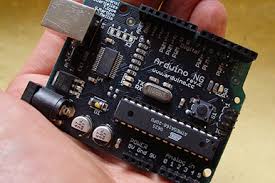Introducing Arduino
A Microcontroller for Everyone
In the 80s and 90s, robotics and phyiscal computing was an expensive and difficult endeavour. A battery-powered computer suitable for robotic and home-automatation experiments cost a few hundred dollars, and required you to learn primitive and esoteric prorgramming languages.
In the 1990s, a group of art and technology teachers in Italy wanted to make a computer that was able to be used by artists and others who just want to do things without having to study computing.
The original Arduino is a rectuangular device about 7x5cm, which has up to 22 “pins” that connect to the outside world, to control sensors, lights, motors and other things. You write programs on your computer and transfer them to the Arduino over its USB cable.

Once programmed, the Arduino retains its program and can be powered by a USB cable from a phone charger, or from a battery (for example from a USB power bank).
The arduino is programmed in a simplified variant of the “C++” programming language, which is known as “Processing”.
There are now dozens of devices compatible with the Processing environment, from the size of a thumbnail up, costing as little as a few dollars.
Resources
- Sparkfun - What is an Arduino?
- Arduino - Getting Started